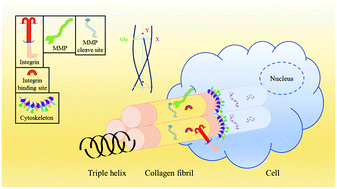当前位置:
X-MOL 学术
›
J. Mater. Chem. B
›
论文详情
Our official English website, www.x-mol.net, welcomes your
feedback! (Note: you will need to create a separate account there.)
Collagen structure regulates MSCs behavior by MMPs involved cell–matrix interactions
Journal of Materials Chemistry B ( IF 6.1 ) Pub Date : 2017-12-04 00:00:00 , DOI: 10.1039/c7tb02377d Yilu Ni 1, 2, 3, 4 , Zhurong Tang 1, 2, 3, 4 , Jirong Yang 1, 2, 3, 4 , Yongli Gao 1, 2, 3, 4 , Hai Lin 1, 2, 3, 4 , Likun Guo 1, 2, 3, 4 , Kai Zhang 1, 2, 3, 4 , Xingdong Zhang 1, 2, 3, 4
Journal of Materials Chemistry B ( IF 6.1 ) Pub Date : 2017-12-04 00:00:00 , DOI: 10.1039/c7tb02377d Yilu Ni 1, 2, 3, 4 , Zhurong Tang 1, 2, 3, 4 , Jirong Yang 1, 2, 3, 4 , Yongli Gao 1, 2, 3, 4 , Hai Lin 1, 2, 3, 4 , Likun Guo 1, 2, 3, 4 , Kai Zhang 1, 2, 3, 4 , Xingdong Zhang 1, 2, 3, 4
Affiliation

|
Various scaffolds have been studied in the formation of cell niches and regulation of mesenchymal stem cells (MSCs) behaviors. Collagen serves as one of the most promising materials for tissue engineering, but the cell–matrix interactions between MSCs and collagen are still poorly understood. In this study, we prepared methacrylated collagen (CMA) and gelatin (GMA) to form photo cross-linking hydrogels. The structure, morphology, mechanical properties and degradation behaviors of the derivatives and hydrogels were characterized and it was found that the advanced structure was the major difference between collagen and gelatin hydrogels. MSCs were encapsulated in the hydrogels and cultured for 14 days in vitro, with or without the tissue inhibitor of metalloproteinase (TIMP). The CCK-8 and CLSM demonstrated that the cells in the CMA hydrogels showed better spreading and proliferation than those in GMA hydrogels. The qRT-PCR and quantitative protein assay verified the inhibition effect of TIMP on metalloproteinases (MMPs). Since the inhibited MMPs led to inferior MSCs adhesion and proliferation, we considered that the appropriate degradation by MMPs would generate more bioactive domains and improve the cell microenvironment. Immunofluorescence staining further proved that the distribution of vitronectin was significantly related to MMP-1 and MMP-2. It was concluded that the differences in the advanced structures of the scaffold materials were amplified to significant differences in multiple biological cell–matrix interactions, and finally led to different cellular fates.
中文翻译:

胶原结构通过涉及细胞-基质相互作用的MMP调节MSC的行为
在细胞壁formation的形成和间充质干细胞(MSCs)行为的调节中研究了各种支架。胶原蛋白是用于组织工程的最有前途的材料之一,但对MSC和胶原蛋白之间的细胞-基质相互作用仍然知之甚少。在这项研究中,我们制备了甲基丙烯酸胶原蛋白(CMA)和明胶(GMA)以形成光交联水凝胶。表征了衍生物和水凝胶的结构,形态,力学性能和降解行为,发现先进的结构是胶原蛋白和明胶水凝胶的主要区别。将MSC包裹在水凝胶中,并在体外培养14天,有或没有组织金属蛋白酶抑制剂(TIMP)。CCK-8和CLSM证明CMA水凝胶中的细胞比GMA水凝胶中的细胞具有更好的扩散和增殖。qRT-PCR和定量蛋白质测定法验证了TIMP对金属蛋白酶(MMP)的抑制作用。由于抑制的MMPs导致MSCs的粘附和增殖较弱,因此我们认为MMPs的适当降解将产生更多的生物活性域并改善细胞微环境。免疫荧光染色进一步证明玻连蛋白的分布与MMP-1和MMP-2显着相关。结论是,支架材料高级结构的差异被放大为多种生物细胞-基质相互作用的显着差异,
更新日期:2017-12-04
中文翻译:

胶原结构通过涉及细胞-基质相互作用的MMP调节MSC的行为
在细胞壁formation的形成和间充质干细胞(MSCs)行为的调节中研究了各种支架。胶原蛋白是用于组织工程的最有前途的材料之一,但对MSC和胶原蛋白之间的细胞-基质相互作用仍然知之甚少。在这项研究中,我们制备了甲基丙烯酸胶原蛋白(CMA)和明胶(GMA)以形成光交联水凝胶。表征了衍生物和水凝胶的结构,形态,力学性能和降解行为,发现先进的结构是胶原蛋白和明胶水凝胶的主要区别。将MSC包裹在水凝胶中,并在体外培养14天,有或没有组织金属蛋白酶抑制剂(TIMP)。CCK-8和CLSM证明CMA水凝胶中的细胞比GMA水凝胶中的细胞具有更好的扩散和增殖。qRT-PCR和定量蛋白质测定法验证了TIMP对金属蛋白酶(MMP)的抑制作用。由于抑制的MMPs导致MSCs的粘附和增殖较弱,因此我们认为MMPs的适当降解将产生更多的生物活性域并改善细胞微环境。免疫荧光染色进一步证明玻连蛋白的分布与MMP-1和MMP-2显着相关。结论是,支架材料高级结构的差异被放大为多种生物细胞-基质相互作用的显着差异,











































 京公网安备 11010802027423号
京公网安备 11010802027423号